Physical Address
304 North Cardinal St.
Dorchester Center, MA 02124
The first trimester of pregnancy is generally considered to be the first 13 completed weeks. In the past, first-trimester ultrasound has mainly been used to confirm fetal viability, establish pregnancy location, count the number of fetuses and assess gestational age by measurement of fetal crown rump length (CRL). A major breakthrough in screening for fetal abnormalities was the finding that fetal nuchal translucency is increased in cases of chromosomal abnormalities and other fetal anatomical defects, and this forms the basis of screening for chromosomal abnormalities in many countries. With further improvements in ultrasound technology it has become increasingly feasible to examine the fetal anatomy in the first trimester. It is advisable to perform the scan at 11 + 0 to 13 + 6 weeks' gestation as this allows confirmation of viability, accurate assesment of gestational age and number of viable fetuses in addition to evaluation of anatomy and calculation of risk of aneuploidy. There are a number of differences and advantages to screening for abnormalities in the first trimester over the second trimester ( Table 1-1 ). The recently published guidelines on the first trimester scan by the International Society of Obstetrics and Gynaecology lists the structures which it should be possible to visualize and assess in the first-trimester routine screening examination. ( Table 1-2 ).
| Advantages of First-Trimester Scanning | Disadvantages of First-Trimester Diagnosis of Fetal Anomalies |
|---|---|
| Establishing fetal viability and excluding early pregnancy complications | Difficulties in technique of transvaginal fetal scanning |
| Confirming multiple pregnancy and determining chorionicity Accurate dating for estimated date of delivery and as a baseline for both first- and second-trimester biochemical screening Early detection of fetal abnormalities Termination of pregnancy may be carried out as a suction curettage |
Inability to detect all abnormalities due to the natural history of some anomalies |
| Significance of minor anomalies unclear at present | |
| Pitfalls in first-trimester diagnosis of fetal anomalies | |
| No pathological confirmation of diagnosis | |
| Nuchal translucency measurement for the detection of chromosomal disease, and as a marker for other syndromes and structural abnormalities, especially cardiac anomalies | High spontaneous loss rate in fetuses with major abnormalities |
| Organ/Anatomical Area | Present and/or Normal? |
|---|---|
| Head | Present |
| Cranial bones | |
| Midline falx | |
| Choroid-plexus-filled ventricles | |
| Neck | Normal appearance |
| Nuchal translucency thickness (if accepted after informed consent and trained/certified operator available) | |
| Face | Eyes with lens * |
| Nasal bone * | |
| Normal profile/mandible * | |
| Intact lips * | |
| Spine | Vertebrae (longitudinal and axial) * |
| Intact overlying skin * | |
| Chest | Symmetrical lung fields |
| No effusions or masses | |
| Heart | Cardiac regular activity |
| Four symmetrical chambers * | |
| Abdomen | Stomach present in left upper quadrant |
| Bladder * | |
| Kidneys * | |
| Abdominal wall | Normal cord insertion |
| No umbilical defects | |
| Extremities | Four limbs each with three segments |
| Hands and feet with normal orientation * | |
| Placenta | Size and texture |
| Cord | Three-vessel cord * |
About 2.8% of pregnancies will be non-viable at 10–13 weeks of gestation and chromosomal abnormalities may be present in 45–70% of these. First-trimester ultrasound is highly accurate in diagnosis of non-viable pregnancies, but it is important to ensure that missed miscarriage is distinguished from a very early viable pregnancy where the fetal heartbeat is simply not seen. This should be of particular concern within the first 6–8 weeks. Recent studies suggest that a mean sac diameter (MSD) cut-off of over 25 mm and a CRL of over 7 mm minimizes the risk of a false-positive diagnosis of miscarriage ( Figures 1-1 and 1-2 ). In cases where these measurements are below the threshold for a one-stop diagnosis a further scan should be arranged in 7 days to assess embryonic or sac growth in that interval.
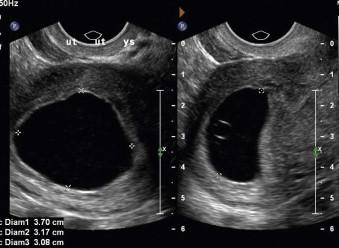
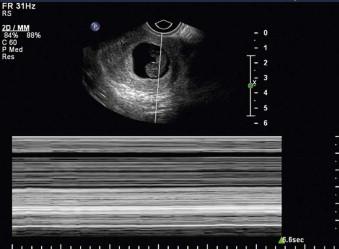
Multiple pregnancy is present in about 3% of first-trimester ultrasound scans, and in these cases assessment of chorionicity is crucial, as antenatal and perinatal complications are greater in monochorionic than dichorionic twin pregnancies. Monochorionic twins have approximately a three- to five-fold increase in perinatal morbidity compared to dichorionic twins. In monochorionic twin pregnancies the majority of the pregnancy losses will occur between the first and the second trimester, and are mostly due to acute twin to twin transfusion syndrome (ATTTS), selective fetal growth restriction, and discordance for fetal anomalies. The presence of the lambda sign (for dichorionicity) or T sign (for monochorionicity) in the first trimester has been shown to be highly reproducible and accurate in determining chrorionicity ( Figures 1-3 and 1-4 ) ( Chapter 9, Assessment of Twin Gestation ). The sensitivity and specificity of ultrasonographic markers for chorionicity (fetal gender assessment, membrane thickness) are much lower when performed in the second trimester.
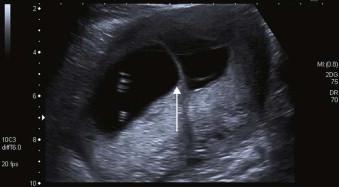
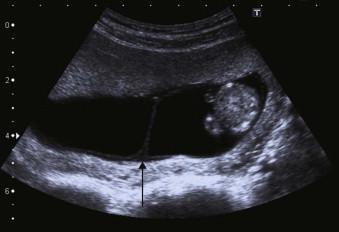
Another important aim of the first trimester scan is gestational age estimation, as up to 30% of women attending an antenatal clinic have uncertain or unreliable menstrual dates. Estimation of gestational age in the first trimester is more reliable compared to second trimester pregnancy dating, and can lead to a reduction in the rate of unnecessary inductions of labour for post-term pregancy. Pregnancy dating is valuable not only for estimating the date of delivery, monitoring fetal growth and timing obstetric interventions; it is also of paramount importance in the assessment of variables that affect first- and second-trimester screening for Down syndrome, such as fetal nuchal translucency and maternal serum biochemistry which change with gestational age.
Recent studies suggest a sensitivity of 85–95% (with a 5% false-positive rate) for the first-trimester detection of Down syndrome using nuchal translucency, free beta human chorionic gonadotrophin (HCG) and pregnancy-associated plasma protein A (PAPP-A) ( Chapter 2, Fetal aneuploidies ). An important feature of increased fetal nuchal translucency measurement is that this finding is also associated with cardiac anomalies, structural abnormalities and genetic syndromes. Fetuses with an increased nuchal translucency measurement and a normal karyotype should therefore have detailed anomaly scanning in the first trimester.
Optimal management is for this to be done at the time of the nuchal translucency (NT) scan but this will depend on the objectives set for the scan locally and the resources available (i.e. time allocated for fetal examination, appropriately trained sonographers and quality of equipment) . Detailed anatomical assessment should be repeated at 20 weeks to look for structural abnormalities. Further follow-up scans may also be indicated and these will depend on the initial amount and/or resolution of increased nuchal fluid.
With improved ultrasound equipment and appropriate training the ability to detect fetal anomalies in the first trimester has continued to improve. One randomized trial suggests that, if experienced operators are performing the examination, detection rates at the first and the second trimester are similar; 38% at 12 weeks vs. 47% at 18 weeks. It has been reported in another randomized trial that if the fetal anatomy evaluation is done at the time of routine NT screening, detection rates can be as good as a dedicated separate focused early anomaly scan in the first trimester. Nevertheless, incomplete fetal anatomical surveys in the first trimester are common and in a study of over 2800 women, the fetal heart and kidneys were not properly visualized in 42% and 27% of cases at the 13-week scan compared with 1–6% and 0% at the mid-trimester scan, respectively. This study showed that transvaginal scanning (TVS) can be used to complement difficult transabdominal scanning (TAS) examinations; complete fetal anatomical surveys were achieved in 82% of cases with TVS and 64% using TAS. Patient body mass index significantly affected the ability of the sonographer to achieve a complete anatomical survey by both TAS and TVS. Other studies concur that adding a TVS may improve detection rates for abnormalities over TAS alone, especially in case of increased BMI, with detection rates doubling from about 30% to about 60%. There may however be technical and practical difficulties in routinely using transvaginal scanning to demonstrate fetal anomalies, for example if a fetus is in a persistently unfavourable presentation; more advanced gestational age; and if women are reluctant to undergo this examination. In addition, a chaperone is required for transvaginal scanning. Because of these issues, while in some centres it is routinely used, in many centres it is used only when necessary.
One factor that needs to be taken into account is that the ability to visualize small structures can vary significantly with advancing gestational age, due to the remarkably rapid fetal organ growth and development in the first trimester. In general, it is thought that scanning before 11 weeks' gestation is less satisfactory, as this often results in incomplete assessment of fetal anatomy. Whitlow and Economides have proposed 13 weeks' gestation as the optimal earliest gestational age to examine fetal anatomy. Nevertheless, in the above-mentioned trial by Chel et al. where women were allocated to undergo a routine NT scan at 11–12 weeks versus a detailed first trimester anatomy scan at 12–13 weeks, performed by experienced operators, the detection rate of anomalies was not significantly different.
From a practical point of view, fetal anomalies fall into three main groups according to whether they are detectable in the first trimester. They can be:
Always detectable – anencephaly, body stalk anomaly, exomphalos, gastroschisis, megacystis, alobar holoprosencephaly.
Sometimes/potentially detectable, e.g. spina bifida, facial cleft, polydactyly, renal agenesis.
Never detectable in first trimester, e.g. microcephaly and Agenesis of the Corpus Callosum (ACC).
In order that first-trimester scanning can be carried out accurately it is important that there is a full understanding of embryological development. In this way some of the potential pitfalls in first-trimester diagnosis may be avoided. The normal midgut herniation of the bowel, which can be present up to 11 weeks' of gestation, should not be confused with an anterior abdominal wall defect ( Figure 1-5 ). Similarly in the brain, the normal single ventricle appearance of the rhombencephalon seen between 7 and 9 weeks' gestation should not be confused with holoprosencephaly ( Figure 1-6 A,B ). In addition to an understanding of the normal development of the fetus, it is also important to be aware that certain fetal abnormalities seen in the second trimester will present in a different manner in the first trimester. A typical example is renal agenesis which will demonstrate severe oligohydramnios at 18–20 weeks but usually has normal liquor volume in the first trimester, as the placenta is the major contributor to amniotic fluid at this stage. Therefore the presence of normal liquor volume at 12–14 weeks does not exclude renal agenesis nor other major renal abnormalities.
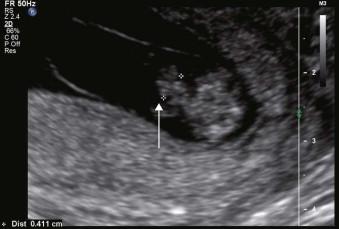
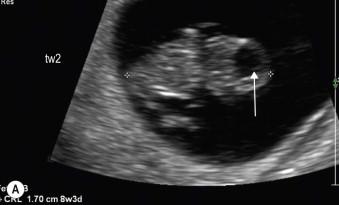
First-trimester diagnosis of abnormalities has many advantages; however one disadvantage is that there is often no pathological confirmation of the diagnosis after surgical termination of pregnancy. This is of importance as studies in later pregnancy have shown that an accurate postmortem examination may alter the sonographic diagnosis. This has significance for clinical genetic counselling in terms of future pregnancies, recurrence risks and the best method of future prenatal diagnosis. However, it has not been demonstrated that lack of information for future pregnancy outcome from pathological examination of a terminated affected pregnancy outweighs the benefits of first-trimester termination.
Another possible disadvantage is that some pregnancies complicated by a serious malformation may miscarry spontaneously in the first or early second trimester. Whilst it may be helpful for parents to understand the reason for the pregnancy loss, this benefit must be weighed against potential harm that results from making parents choose to terminate a wanted pregnancy that might in any case have been lost spontaneously. Nevertheless, many major anomalies do not result in miscarriage, and early diagnosis affords parents choices including the option of expectant management.
Dedicated first-trimester screening studies using transabdominal/transvaginal scanning show detection rates in the range of 31–65% in low-risk populations and 54–74% in high-risk pregnancies.
Two studies have compared the detection rates of transabdominal scanning to transvaginal scanning and documented improvements in the detection rates from 29% to 57% and 35% to 65%. These studies also demonstrated that second-trimester scanning picked up additional anomalies with detection rates in the range of 16–48%, and that there was a significant percentage of anomalies not seen until the third trimester and the neonatal period. In one of the largest recent published series of routine first-trimester screening the detection rate of the first-trimester scan alone for non-chromosomal abnormality was 43.6% compared to 97.4% for the first- and second-trimester scans together. The second-trimester scan was performed at 20–23 weeks' gestation. In a literature review of 15 screening studies reported in the above-mentioned paper, the detection rate of fetal abnormalities in the first trimester was 48.3% ( Table 1-3 ).
| detection rates (%) | |||||||
|---|---|---|---|---|---|---|---|
| First Trimester | |||||||
| Author | Type of Population | Number in Study | Trans-Abdominal | Trans-Vaginal | Second Trimester | Third Trimester | Missed Anomalies (%) |
| Constantine and McCormack 1991 * | LR | 3565 | 14 | 14 | 36 | 36 | |
| Chambers et al. 1995 | LR | 19,497 | 13 | 52 | 20 | 15 | |
| Achiron and Tadmore 1991 | HR | 800 | 29 | 57 | 36 | – | 7 |
| Yagel et al. 1995 | HR | 536 | 74 | 16 | – | 10 | |
| Hernandi and Torocsik 1997 | LR | 3991 | 41 | 19 | 20 | 20 | |
| D'Ottavio et al. 1997 | LR | 3490 | 32 | 48 | 5 | 15 | |
| Economides and Braithwaite 1998 | LR | 1632 | 35 | 65 | 18 | – | 17 |
| Carvalho et al. 2002 | LR | 2853 | 31 | 40 | 29 | ||
| Chen et al. 2004 | HR | 1609 | 54 | 23 | 23 | ||
These studies suggest that first-trimester scanning is unlikely to replace routine mid-trimester screening for fetal abnormalities. First-trimester anomaly scanning should be used in addition to, rather than instead of, second-trimester anomaly scanning. There are some abnormalities that should always be detected in the first trimester and others that can never be detected. Knowledge of the association of easily identifiable ultrasound markers with specific fetal abnormalities can improve the detection rates, e.g. increased nuchal translucency and cardiac abnormality (see below – next section).
The type and range of anomalies detected in the first trimester differs from those seen in the second trimester, with high incidences of severe intracranial anomalies such as anencephaly, exencephaly and holoprosencephaly. In addition, increased nuchal translucency and hydrops are common findings. Other common anomalies seen are anterior abdominal wall defects, renal anomalies and skeletal dysplasias ( Table 1-4 ).
| Organ/System | Number | Percentage of Total | Anomaly | Number |
|---|---|---|---|---|
| Central nervous system | 30 | 25% | Anencephaly/exencephaly | 16 |
| Ventriculomegaly | 7 | |||
| Dandy–Walker syndrome | 3 | |||
| Holoprosencephaly | 2 | |||
| Encephalocoele | 2 | |||
| Neck | 22 | 18% | Cystic hygroma | 22 |
| Cardiac * | 14 | 11–5% | Tetralogy of Fallot | 3 |
| Hypoplastic left heart | 3 | |||
| Hypoplastic right heart | 1 | |||
| Truncus arteriosus | 1 | |||
| Ebstein's anomaly | 1 | |||
| Ventricular septal defect | 2 | |||
| Aortic stenosis | 1 | |||
| Complex cardiac anomaly | 2 | |||
| Renal | 14 | 11–5% | Hydronephrosis | 5 |
| Bladder outletobstruction/megacystis | ||||
| 4 | ||||
| Cystic renal disease | 4 | |||
| Renal agenesis | 1 | |||
| Abdomen | 12 | 10% | Anterior abdominal wall defects | 12 |
| Body | 9 | 7.5% | Oedema/hydrops | 9 |
| Musculoskeletal | 5 | 4% | Skeletal dysplasias | 5 |
| Spine | 4 | 3.3% | Spina bifida | 4 |
| Face | 2 | 1–5% | Facial clefting | 2 |
* 11 out of the 14 cardiac anomalies were detected in study reference .
There is increasing evidence that as well as being associated with a high risk of chromosomal disease ( Chapter 2, Fetal aneuploidies ) an increased nuchal translucency measurement is also associated with structural anomalies and rare syndromes ( Table 1-5 ) (see Chapter 7, Fetal Anomalies – The Geneticist's Approach ; Chapter 8, Diagnosis of Hydrops and Multiple Malformation Syndromes ).
| Common Conditions |
|
| Rare Conditions |
| Skeletal Dysplasias |
|
| Genetic Syndromes |
|
The observed prevalence for some abnormalities such as anencephaly, holoprosencephaly, microcephaly, facial cleft, gastroschisis, renal abnormalities, bowel obstruction and spina bifida, may not be different from that in the general population. However the prevalence of major cardiac defects, diaphragmatic hernia, exomphalos, body-stalk anomaly and fetal akinesia deformation sequence appears to be substantially higher than in the general population, indicating an association between these abnormalities and increased nuchal translucency thickness. Similarly, there may be an association between increased nuchal translucency and a wide range of skeletal dysplasias and genetic syndromes that are usually found in less than 1 in 10,000 pregnancies ( Table 1-5 ). Fetuses with increased nuchal translucency should therefore undergo expert ultrasonography with a particular emphasis on fetal cardiac anatomy if the karyotype is normal.
The gestational sac may be recognized as early as 4 weeks and 1 day from the last menstrual period and should always be seen after 4 weeks and 4 days. Its diameter when first seen is about 2 mm and the normal sac increases in size to measure 5–6 mm at 5 weeks. The mean gestational sac diameter then increases by approximately one millimetre per day throughout the first trimester. The yolk sac should be visible from 5 weeks' gestation and increases in size to a maximum mean diameter of 6 mm at 10 weeks' gestation. The majority of yolk sacs decrease in size before disappearing at around 12 weeks' gestation. Some yolk sacs, however, will increase in size before disappearing.
The fetal pole is usually visible towards the end of the 5th week, the embryo is first seen as a nubbin of tissue adjacent to but distinct from the yolk sac, developing along the chorionic margin of the yolk sac; it is approximately 2 mm in length at 5 weeks. At 6 weeks the developing embryo appears as an echogenic disc of about 5 mm tangentially touching and closely attached to the yolk sac ( Figure 1-7 ). Prior to 5 weeks the beat of the developing embryonic heart will often be seen without the embryo itself. Once it is larger than 2 mm it is discoid with a reasonable and proportional width relative to its length, the normal embryonic growth rate is initially 1–2 mm/day. Once it measures 5 mm in a sac of 15 to 18 mm size, (a gestational age of approximately 6.5 weeks) it will be seen consistently as a discrete structure and it will always have cardiac pulsations at this stage if it is alive.
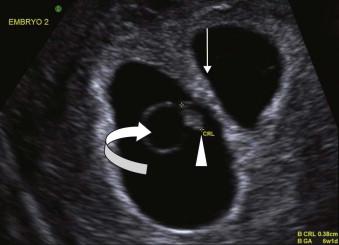
Before this gestational age the greatest fetal pole length is difficult to estimate with a high interobserver variability (the crown–rump length is impossible to visualize at an early stage), therefore any dating scan should not be performed earlier than a CRL <5 mm.
The fetal heartbeat should be demonstrated from 6 weeks' gestation ( Figure 1-8 ) when the normal heart rate is approximately 120 beats per minute. From 5 to 9 weeks of gestation there is a rapid increase in the mean heart rate from 110 to 175 bpm. The amniotic sac is seen surrounding the developing fetus and the yolk sac lies outside the amniotic sac within the extra embryonic coelom ( Figure 1-9 ).
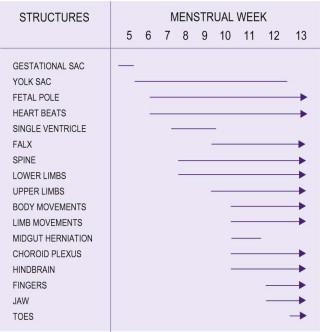

The central nervous system develops from the neural tube and at 5 weeks' gestation the cephalic end separates into three primary brain vesicles: prosencephalon (forebrain), mesencephalon (midbrain) and rhombencephalon (hind brain). At 6 weeks' gestation the secondary brain vesicles occur and the prosencephalon differentiates into the telencephalon and diencephalon, the mesencephalon remains unchanged and the rhombencephalon divides into the metencephalon and myeloencephalon. Between 7 and 8 weeks the fetal cephalic pole is clearly distinguishable from the fetal torso. On sagittal scanning the rudimentary brain vesicles can be demonstrated ( Figure 1-10 ) and on coronal scanning a single ventricle appearance can be seen representing the rhombencephalon ( Figure 1-6A ). Towards the end of the 8th week the brain is divided by an echogenic line representing the falx cerebri and the biparietal diameter is approximately 8 mm. The choroid plexuses appear soon after the falx as echogenic structures, almost completely filling the lateral ventricles ( Figure 1-11 A,B ). In the rhombencephalon the cerebellar hemispheres develop at the beginning of the 8th week as two laterally placed masses separated in the midline. During the 10th week the cerebellar hemispheres unite in the midline to form the definitive cerebellum ( Figure 1-12 ). The posterior fossa structures can be visualized during the first trimester and specific nomograms have been reported for the transcerebellar diameter, cisterna magna and the fourth ventricle. Ossification of the skull bones commences at 10 weeks and is complete at 11–12 weeks. The basic structure of the brain is therefore present at 11–12 weeks' gestation. The stages at which various intracranial structures can be demonstrated using transvaginal ultrasound is outlined in Figure 1-13 .
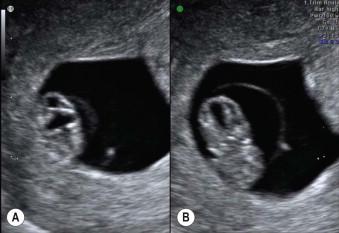
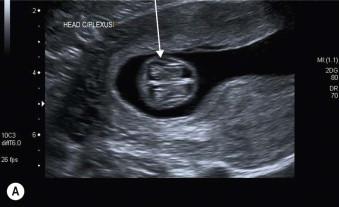
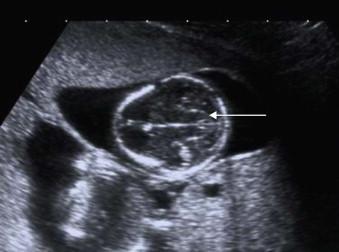
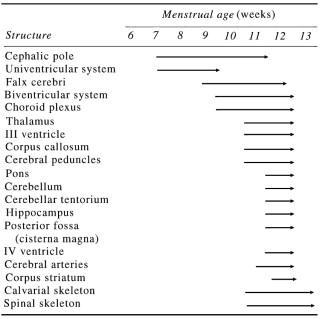
The development of the spine is marked by the fact that at 5.5 weeks' gestation the neural folds are already fused, and the neural tube is already developed and covered by the neural crest and ectoderm.
Before 10 weeks the spine can be seen as hypoechogenic parallel lines ( Figure 1-14 ). After 10 weeks the spine starts to ossify: within the neural arches of the lumbosacral region, ossification progresses caudally at a rate of one vertebral level every 2 to 3 weeks after 16 weeks ( Figure 1-15 ); however ossification of the sacrum may not be complete until 25 weeks' gestation.
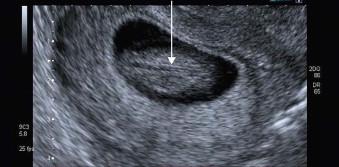
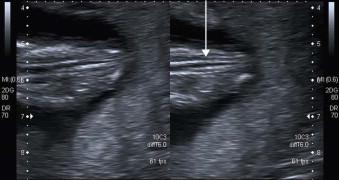
The cardiovascular system begins to develop during the 3rd embryonic week and the fetal heartbeat can be discerned from the beginning of the 6th week. The heart gradually attains a tubular structure that resembles a trilocular cavity at the end of the 10th week. Formation of the septae, and arterial and venous connections are completed only after 8 weeks' gestation. A four-chamber view may be obtained at 10 weeks' gestation, but it is seen in the majority of fetuses after 12 weeks' gestation and in all cases only after 13 weeks ( Figure 1-16 A–E ).

With modern equipment good views of the fetal heart may be possible using transabdominal imaging alone, but full assessment using transvaginal scanning in the first trimester may be necessary; this can be difficult due to the limitations of manoeuvrability of the transvaginal probe. Success rates vary between 43% and 95% at 13 weeks and 46% and 98% at 14 weeks due to differences in operator experience, equipment, and population settings (tertiary centres or low-risk population screenings) (see Chapter 14 Cardiac Abnormalities and Arrhythmias ).
The fetal kidneys can be identified as early as 9 weeks' gestation. However, at 12 weeks' gestation the kidneys can be demonstrated in 86–99% of fetuses and at 13 weeks in 92–99%. The upper limit of normal for the anteroposterior diameter of the renal pelvis is 3 mm and nomograms for renal size have also been reported for the first trimester. In the first trimester the kidneys appear as oval echogenic structures on either side of the spine ( Figure 1-17 ) and the bladder is seen as small echo-free area within the pelvis. Colour flow Doppler is useful to confirm the location of the bladder ( Figure 1-18 ). Recent studies have shown that the bladder may be demonstrated in 88% of fetuses at 12 weeks' gestation and 92–100% at 13 weeks' gestation. The longitudinal bladder/length is usually less than 6 mm in the first trimester.
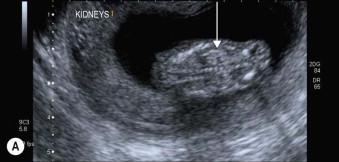
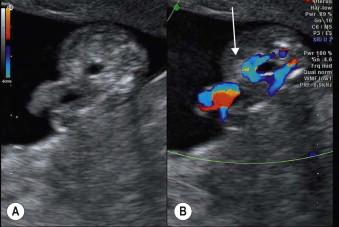
Early determination of the fetal sex is gestational-age dependent. Up to 6 weeks' gestation the external genitalia of the male and female are indifferent, and differentiation occurs between 8 and 11 weeks' gestation. Sex determination should be possible after 12 weeks' gestation. Female genitalia are visualized as two or four parallel lines that represent the labia major and minora and, on sagittal scanning the clitoris is caudally directed. Male fetuses demonstrate a uniform, non-septated dome-shaped structure at the base of the fetal penis. The testes will not be demonstrated as they have not yet descended into the scrotum. Sagittal scanning will reveal the cranially directed penis ( Figure 1-19 B and C ). Accuracy rates range from 60% to 100% in studies reporting the fetal sex diagnoses from 10 to 14 weeks.

During the 6th menstrual week, the right and left lateral folds form and the dorsal part of the yolk sac is incorporated into the embryo to form the primitive gut. The remaining yolk sac (secondary) pinches off the developing midgut loop, but remains connected to the gut by a stalk called the vitteline duct. Three distinct areas of primitive gut are identified: the foregut, the midgut and the hindgut.
The foregut gives rise to the oesophagus, trachea, stomach, liver, gall bladder and biliary ducts. The stomach is identified as a sonolucent cystic structure in the left upper quadrant. It can be demonstrated as early as 8 weeks' gestation; however, at 12 weeks it is seen in 97% of fetuses ( Figure 1-20 ). It is thought that fetal swallowing does not begin until 12–13 weeks' gestation and so the fluid present in the fetal stomach before this time is likely to represent gastric secretions.
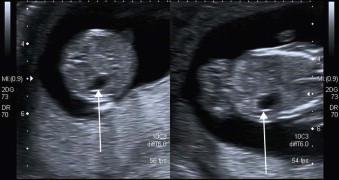
The gall bladder emanates from the caudal part of the hepatic diverticulum at 7 weeks' gestation and bile starts to form at approximately 14 weeks. The gall bladder is usually not detectable until 13 weeks' gestation, when it is seen in 50% of fetuses. At 14 weeks it is normally seen in all cases.
During the 7th week of gestation, due to extensive lengthening of the midgut and the enlargement of the liver, a portion of intestinal loop moves outside the abdomen and protrudes into the proximal umbilical cord ( Figure 1-5 ). Within the cord the midgut grows further and rotates clockwise through 90° around the axis of the superior mesenteric artery. This midgut herniation starts from the 7th week and persists until the 11th week. It should spontaneously resolve by the 12th week. Recent studies reveal that transverse measurements of the midgut herniation should not exceed 7 mm at any gestation and that no herniation should be present in a fetus with a crown rump length greater than 45 mm. However, there are some case reports of transient fetal omphalocoele or delayed reduction of the physiological midgut herniation with a favourable outcome.
Limb buds are first seen by ultrasound at about the 8th week of gestation: the upper limb buds of the humeri are seen at 8 weeks, one week before the femora, the tibia/fibula and radius/ulna from 10 weeks, and digits of hands and feet from 11 weeks. In early gestation, the fetus tends to keep the hands open with fingers extended ( Figure 1-21 ), facilitating their visualization, unlike the second trimester when the hands are usually held in a flexed position. Similarly the feet are held with heels almost touching and knees slightly flexed, which also makes their visualization easier ( Figure 1-22 A and B ).
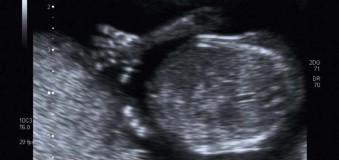
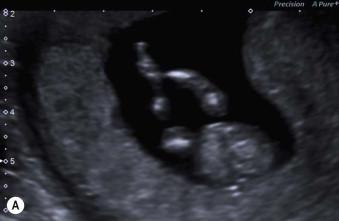
The bones of the maxilla and mandible can be demonstrated as early as 9–10 weeks and the orbits by 10–11 weeks' gestation. At 11 weeks the lenses of the eyes can be seen as tiny ring-like structures and may be demonstrated in all fetuses from the 14th week. Between the 6th and 12th week the profile changes: at 7 weeks the forehead tends to dominate the face and the maxilla grows faster than the mandible. By 12 weeks the mandible catches up and reaches the size of the maxilla. The nose and lips finally form at 11 weeks and the palate at 12 weeks. By 12 weeks the basic anatomy of the face is complete ( Figure 1-23 ).
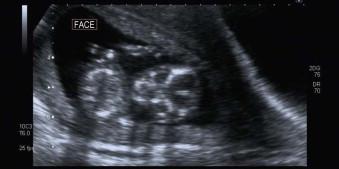
Become a Clinical Tree membership for Full access and enjoy Unlimited articles
If you are a member. Log in here